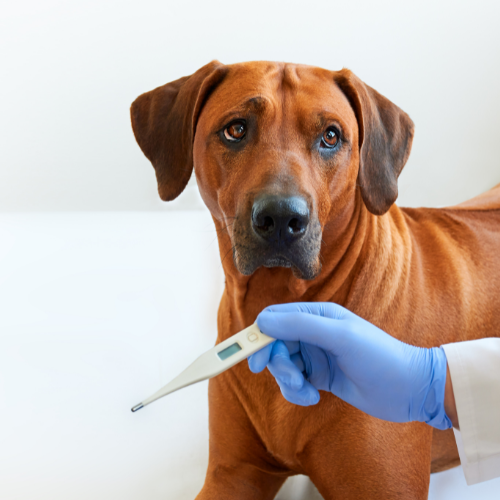How to Tell If a Dog Has a Fever
As a dog owner, it’s crucial to keep our furry friends healthy and happy. One common concern is how to tell if a dog has a fever. A fever can be a sign of an underlying health issue, and knowing how to detect it can help you provide the necessary care for your pet. In this article, we’ll explore the importance of understanding your dog’s normal body temperature, methods for checking their temperature, and signs that may indicate a fever. By being well-informed, you can ensure your dog receives proper care and treatment when needed.

Normal Body Temperature for Dogs
A dog’s normal body temperature typically falls within a specific range. Understanding this range is essential for identifying potential health issues, such as fever. The typical temperature range for dogs is:
- 99.5°F to 102.5°F (37.5°C to 39.2°C)
It’s important to monitor your pet’s temperature, as both fever and hypothermia can be indicators of underlying health problems. Keep in mind that individual dogs may have slightly different baseline temperatures, but knowing the general range can help you determine if your dog’s temperature is cause for concern.
Methods for Checking a Dog’s Temperature
To accurately determine if your dog has a fever, you’ll need to check their temperature. There are several methods you can use to measure your dog’s temperature:
- Rectal thermometer: This is the most accurate method. Gently insert a lubricated digital thermometer about an inch into your dog’s rectum and wait for the reading. It’s best to have someone help you hold your dog still during this process.
- Ear thermometer: These thermometers are designed specifically for dogs and measure the temperature of the ear canal. While they may be easier to use, they can be less accurate due to the presence of hair, wax, and debris in the ear canal.
- Infrared thermometer: This non-contact method measures the temperature of your dog’s skin. Although it’s the least invasive option, it may be less accurate than the other methods.
Choose the method that works best for you and your dog, and remember to always handle your pet gently and calmly during the process.

Common Symptoms of Fever in Dogs
If you suspect your dog has a fever, it’s essential to be aware of the signs that may indicate its presence. Some common symptoms of fever in dogs include:
- Lethargy or lack of energy
- Loss of appetite
- Shivering or trembling
- Warm, dry nose
- Red or glassy-looking eyes
- Warm ears
- Panting or rapid breathing
- Runny nose
Keep in mind that these symptoms can also be associated with other health issues, so it’s important to monitor your dog closely and consult a veterinarian if you’re concerned about their well-being.
Potential Causes of Fever in Dogs
There are various factors that can lead to fever in dogs. Some of the most common causes include:
- Infections: Bacterial, fungal, viral, or parasitic infections can all trigger a fever in dogs as their body attempts to fight off the invading pathogens.
- Inflammation: Inflammatory conditions, such as autoimmune disorders or localized inflammation from an injury, can cause a fever.
- Toxins: Ingestion of poisonous materials, such as toxic plants, human medications, or certain human foods, can lead to fever in dogs.
- Vaccination reactions: Some dogs may develop a mild fever after receiving vaccinations as their immune system responds to the vaccine.
- Heatstroke: Overexposure to high temperatures can cause heatstroke, which may present with fever-like symptoms.
- Cancer: Certain types of cancer can cause fever as the body tries to combat the abnormal cell growth.
It’s important to consult a veterinarian if your dog has a fever, as they can help determine the underlying cause and recommend appropriate treatment.

When to Consult a Veterinarian
It’s essential to seek professional help for a dog with a fever in certain situations. Consult your veterinarian if:
- Your dog’s temperature is 103°F (39.4°C) or higher
- The fever lasts more than 24 hours
- Your dog exhibits severe symptoms or appears to be in pain
- The fever is accompanied by other concerning symptoms, such as vomiting, coughing, or difficulty breathing
A temperature of 106°F (41.1°C) or higher can be life-threatening, as it can damage your dog’s internal organs. In such cases, seek immediate veterinary care. Remember, it’s always better to err on the side of caution and consult your veterinarian if you’re unsure about your dog’s health.
Home Care for a Dog with a Fever
If your dog has a fever, there are several steps you can take to provide comfort and care at home while waiting for a veterinarian appointment:
- Keep your dog hydrated: Ensure they have access to fresh, cool water. Encourage them to drink, but don’t force it.
- Provide a comfortable environment: Offer your dog a quiet, cool place to rest, away from direct sunlight or heat sources.
- Apply cool compresses: Use a cloth soaked in cool water to gently wipe down your dog’s ears, paws, tummy, and chest. This can help lower their body temperature.
- Monitor their temperature: Regularly check your dog’s temperature using one of the methods mentioned earlier. This will help you track their progress and determine if further intervention is needed.
- Keep an eye on symptoms: Observe your dog closely for any changes in their symptoms or behavior.

Remember, never give your dog human medications intended to lower fever without consulting a veterinarian. Always follow your vet’s advice and recommendations for treating your dog’s fever.
Preventing Fever in Dogs
Maintaining your dog’s health and preventing fever involves several key aspects of care. Here are some suggestions to help keep your dog healthy:
- Vaccinations: Ensure your dog is up-to-date with their vaccinations, as they can protect against various diseases and infections that may cause fever.
- Regular vet check-ups: Schedule routine veterinary visits for your dog to monitor their overall health and catch any potential issues early.
- Parasite prevention: Administer medications to prevent heartworms, fleas, ticks, and other parasites, as these can cause health problems, including fever.
- Weight management: Help your dog maintain a healthy weight through a balanced diet and regular exercise, as obesity can contribute to various health issues.
- Proper hygiene: Regular grooming and dental care can help prevent infections and inflammation that may lead to fever.
- Avoid exposure to toxins: Keep your dog away from toxic substances, such as poisonous plants, chemicals, and certain human foods, which can cause fever or other health problems.
- Tick control: Use tick prevention products and check your dog regularly for ticks, as tick-borne diseases can cause fever.
By following these guidelines, you can help maintain your dog’s health and reduce the risk of fever and other health issues.
Fever in Puppies
Detecting and addressing fever in puppies is particularly important, as their developing immune systems may make them more susceptible to illness. Here’s how to detect and address fever in puppies specifically:
Detecting Fever in Puppies
The signs of fever in puppies are similar to those in adult dogs. Keep an eye out for the following symptoms:
- Lethargy or lack of energy
- Loss of appetite
- Shivering or trembling
- Warm, dry nose
- Red or glassy-looking eyes
- Warm ears
- Panting or rapid breathing
Addressing Fever in Puppies
If you suspect your puppy has a fever, take the following steps:
- Check their temperature: Use one of the methods mentioned earlier (rectal thermometer, ear thermometer, or infrared thermometer) to measure your puppy’s temperature.
- Consult a veterinarian: Puppies may be more vulnerable to health issues, so it’s essential to consult a veterinarian if you suspect your puppy has a fever. They can diagnose the underlying cause and recommend appropriate treatment.
- Provide home care: While waiting for your vet appointment, ensure your puppy has access to fresh water, a comfortable environment, and monitor their temperature and symptoms.
Remember, always consult a veterinarian for professional advice and guidance when it comes to your puppy’s health.
Conclusion
In summary, monitoring your dog’s health and knowing how to detect a fever is crucial for every dog owner. By understanding the normal body temperature range for dogs, using appropriate methods to check their temperature, and being aware of the common symptoms of fever, you can ensure your dog receives proper care and treatment when needed. It’s essential to consult a veterinarian if you suspect your dog has a fever, as they can diagnose the underlying cause and recommend appropriate treatment. By following preventive measures and maintaining your dog’s overall health, you can reduce the risk of fever and other health issues, helping your furry friend live a happy and healthy life.
FAQ
- What is a normal body temperature for a dog? A dog’s normal body temperature ranges from 101 to 102.5 degrees Fahrenheit (38.3 to 39.2 degrees Celsius).
- What temperature is considered a fever in dogs? A temperature above 102.5 degrees Fahrenheit (39.2 degrees Celsius) is generally considered a fever in dogs.
- What are the common symptoms of a fever in dogs? Common symptoms include lethargy, loss of appetite, shivering, warm and dry nose, red or glassy eyes, increased heart rate, and panting.
- How can I accurately determine if my dog has a fever? You can determine if your dog has a fever by using a rectal thermometer, ear thermometer, or infrared thermometer to check their temperature.
- What is the best method for taking a dog’s temperature? The most accurate method for taking a dog’s temperature is using a rectal thermometer.
- Can I rely on the “nose test” to determine if my dog has a fever? The nose test is not a reliable method for determining if a dog has a fever, as a warm and dry nose can be caused by various factors.
- What are the potential causes of fever in dogs? Potential causes include infections, inflammation, heatstroke, vaccination reactions, autoimmune diseases, and cancer.
- Are there any complications associated with high fever in dogs? High fever in dogs can lead to dehydration, organ damage, and other complications if left untreated.
- How should I care for a dog with a fever? Provide fresh water, a comfortable environment, and monitor their temperature and symptoms. Consult a veterinarian for proper diagnosis and treatment.
- When should I consult a veterinarian if my dog has a fever? Consult a veterinarian if your dog’s temperature is 103°F (39.4°C) or higher, the fever lasts more than 24 hours, or if your dog exhibits severe symptoms or appears to be in pain.
Hi, I’m John and I love dogs. Ever since I was a kid, I always wanted to have a furry friend by my side. I grew up with a golden retriever named Max, who taught me a lot about loyalty, friendship, and fun. He was my best buddy for 12 years, and I miss him every day.
